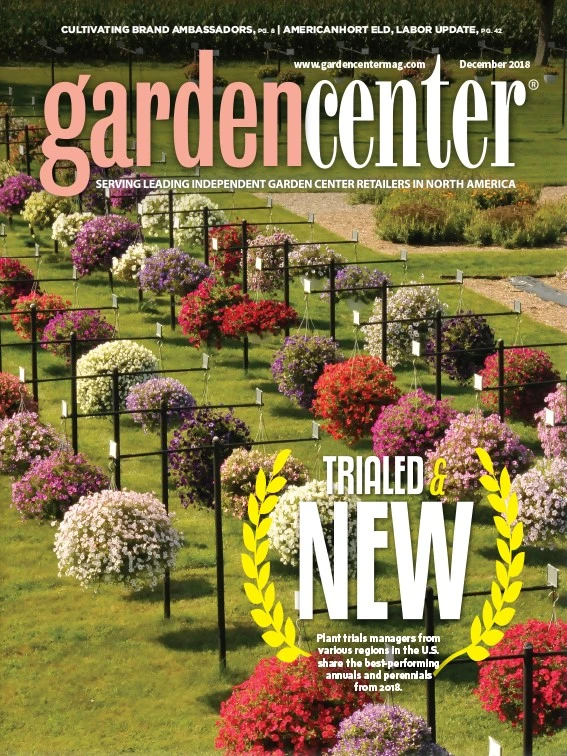
Photo courtesy of The American Phytopathological Society

This past September, Dr. Raymond Cloyd from Kansas State University, Margery Daughtrey from Cornell University and Dr. A.R. Chase from Chase Horticultural Research released a book tilted “Compendium of Bedding Plant Diseases and Pests.” The 170-page book, published by The American Phytopathological Society (APS), features information on the many infectious and abiotic diseases affecting bedding plants sorted by their cause, as well as an overview of common arthropod pests such as aphids, fungus gnats and greenhouse thrips.
The trio originally discussed writing the book nine years ago at OFA Short Course — before it was rebranded as Cultivate — and have been working on the book for the past several years. Cloyd, an extension specialist at Kansas State University, wrote the section about pests, while Daughtrey, a senior extension associate at Cornell University, and Chase, president of Chase Horticultural Research co-wrote the sections covering diseases.
“We sat around at a table there and started the conversation,” Cloyd says. “It was us sitting down and saying ‘Hey, there’s no book on diseases and pests for greenhouses and landscapes.’”
“We had an interest in filling that gap,” Daughtrey says. “The way these APS books work, they are very comprehensive and that section of the industry needed this.”
The book is available through APS for $139 or $125.10 for APS members at bit.ly/bedding-disease-compendium It is not currently available in a digital format.

of respective sources
Greenhouse Management: The book says that the 1970s were the heyday of bedding plants and that the information growers need to grow bedding plants now hasn’t been updated much since then. What exactly has changed?
Raymond Cloyd: Growers have really diversified. Basically, the heyday we talk about, the ’70s and ’80s, growers were only growing bedding plants — marigolds, petunias, etc. Now, you have growers producing vegetables and other plants at the same time. Although I think that while the bedding plant industry is doing well and crops like New Guinea impatiens are so popular, growers are diversifying because of the market and trying to find new niches. You don’t have a grower just growing bedding plants anymore.
When you grow other crops along with bedding plants, you’re going to have different pests. If you’re going to apply pesticides and you’re growing herbs along with your bedding plants, there’s an issue there because herbs are consumable and bedding plants are not. The challenges are trying to find products you can use on both or you’re going to have to do isolated, localized sprays and minimize the drift on the herbs. The same logic applies to vegetables.
GM: In the pest section, what information will be most helpful to growers?
RC: I think the initial overview of pests will be quite valuable because it covers a whole range of topics. I think the tables in there will be really helpful to growers and help guide them to coherently solve their problems. They don’t have to dig for the information — it’s going to be there in table format for them. This is something growers need on their bookshelves.
GM: What are some of the challenges of a project like this one?
Margery Daughtrey: It takes a lot of time to get the illustrations for all of this right. You have to go through what you’ve got to find the perfect one. With bedding plants, it’s more challenging because most books that APS publishes are one plant at a time — so it’s everything you want to know about soybeans or everything you want to know about sunflowers, for example. But with this book, we were covering 125 different plants. Each time we covered a pathogen, we had to find all of the plants that interacted with that pathogen in a way that caused it to be recorded or researched.
GM: What are some of the main highlights of the disease section that you think will jump out to growers?
MD: There are a number of colored illustrations throughout the book, which is nice because you can see exactly what we are talking about at any given place. They can see, for example, the symptoms of tomato spotted wilt virus or necrotic wilt. They can learn what Botrytis looks like and see what a fusarium wilt infection on a cyclamen looks like. There are a lot of bits of learning that come from the illustrations. Another thing I think people will be really excited about is one giant table that I know [Chase] worked really hard on. It’s a fungicide listing organized so all of the pathogens are listed across the top on a double-page spread, and the different fungicides are listed down the other side. You can see what products have an effect on a particular pathogen. That’s something that doesn’t exist anywhere else.

Explore the December 2018 Issue
Check out more from this issue and find your next story to read.
Latest from Garden Center
- [WATCH] Looking Back to Spring Ahead: Where we’ve been & where the industry is headed in 2026
- Seed Your Future plans to bring 80+ students to MANTS 2026
- Donna McGinnis named next CEO of Denver Botanic Gardens
- HRI Leadership Academy opens applications for 2027 class
- Sustainabloom introduces Sustainability Planning Template for Retail Florists
- Burpee releases commemorative seed collection to celebrate America's 250th anniversary
- New Michigan box tree moth alert available in English and Spanish
- Seed Your Future announces board updates, 2025 Cross-Curricular Career Lessons





